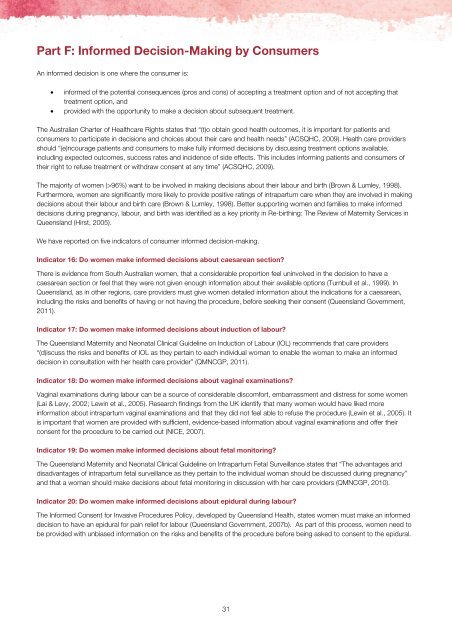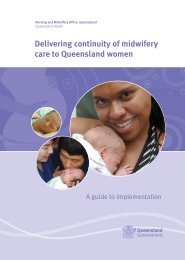Proserpine Hospital - Queensland Centre for Mothers & Babies
Proserpine Hospital - Queensland Centre for Mothers & Babies
Proserpine Hospital - Queensland Centre for Mothers & Babies
Create successful ePaper yourself
Turn your PDF publications into a flip-book with our unique Google optimized e-Paper software.
Part F: In<strong>for</strong>med Decision-Making by Consumers<br />
An in<strong>for</strong>med decision is one where the consumer is:<br />
• in<strong>for</strong>med of the potential consequences (pros and cons) of accepting a treatment option and of not accepting that<br />
treatment option, and<br />
• provided with the opportunity to make a decision about subsequent treatment.<br />
The Australian Charter of Healthcare Rights states that “(t)o obtain good health outcomes, it is important <strong>for</strong> patients and<br />
consumers to participate in decisions and choices about their care and health needs” (ACSQHC, 2009). Health care providers<br />
should “(e)ncourage patients and consumers to make fully in<strong>for</strong>med decisions by discussing treatment options available,<br />
including expected outcomes, success rates and incidence of side effects. This includes in<strong>for</strong>ming patients and consumers of<br />
their right to refuse treatment or withdraw consent at any time” (ACSQHC, 2009).<br />
The majority of women (>96%) want to be involved in making decisions about their labour and birth (Brown & Lumley, 1998).<br />
Furthermore, women are significantly more likely to provide positive ratings of intrapartum care when they are involved in making<br />
decisions about their labour and birth care (Brown & Lumley, 1998). Better supporting women and families to make in<strong>for</strong>med<br />
decisions during pregnancy, labour, and birth was identified as a key priority in Re-birthing: The Review of Maternity Services in<br />
<strong>Queensland</strong> (Hirst, 2005).<br />
We have reported on five indicators of consumer in<strong>for</strong>med decision-making.<br />
Indicator 16: Do women make in<strong>for</strong>med decisions about caesarean section<br />
There is evidence from South Australian women, that a considerable proportion feel uninvolved in the decision to have a<br />
caesarean section or feel that they were not given enough in<strong>for</strong>mation about their available options (Turnbull et al., 1999). In<br />
<strong>Queensland</strong>, as in other regions, care providers must give women detailed in<strong>for</strong>mation about the indications <strong>for</strong> a caesarean,<br />
including the risks and benefits of having or not having the procedure, be<strong>for</strong>e seeking their consent (<strong>Queensland</strong> Government,<br />
2011).<br />
Indicator 17: Do women make in<strong>for</strong>med decisions about induction of labour<br />
The <strong>Queensland</strong> Maternity and Neonatal Clinical Guideline on Induction of Labour (IOL) recommends that care providers<br />
“(d)iscuss the risks and benefits of IOL as they pertain to each individual woman to enable the woman to make an in<strong>for</strong>med<br />
decision in consultation with her health care provider” (QMNCGP, 2011).<br />
Indicator 18: Do women make in<strong>for</strong>med decisions about vaginal examinations<br />
Vaginal examinations during labour can be a source of considerable discom<strong>for</strong>t, embarrassment and distress <strong>for</strong> some women<br />
(Lai & Levy, 2002; Lewin et al., 2005). Research findings from the UK identify that many women would have liked more<br />
in<strong>for</strong>mation about intrapartum vaginal examinations and that they did not feel able to refuse the procedure (Lewin et al., 2005). It<br />
is important that women are provided with sufficient, evidence-based in<strong>for</strong>mation about vaginal examinations and offer their<br />
consent <strong>for</strong> the procedure to be carried out (NICE, 2007).<br />
Indicator 19: Do women make in<strong>for</strong>med decisions about fetal monitoring<br />
The <strong>Queensland</strong> Maternity and Neonatal Clinical Guideline on Intrapartum Fetal Surveillance states that “The advantages and<br />
disadvantages of intrapartum fetal surveillance as they pertain to the individual woman should be discussed during pregnancy”<br />
and that a woman should make decisions about fetal monitoring in discussion with her care providers (QMNCGP, 2010).<br />
Indicator 20: Do women make in<strong>for</strong>med decisions about epidural during labour<br />
The In<strong>for</strong>med Consent <strong>for</strong> Invasive Procedures Policy, developed by <strong>Queensland</strong> Health, states women must make an in<strong>for</strong>med<br />
decision to have an epidural <strong>for</strong> pain relief <strong>for</strong> labour (<strong>Queensland</strong> Government, 2007b). As part of this process, women need to<br />
be provided with unbiased in<strong>for</strong>mation on the risks and benefits of the procedure be<strong>for</strong>e being asked to consent to the epidural.<br />
31
















